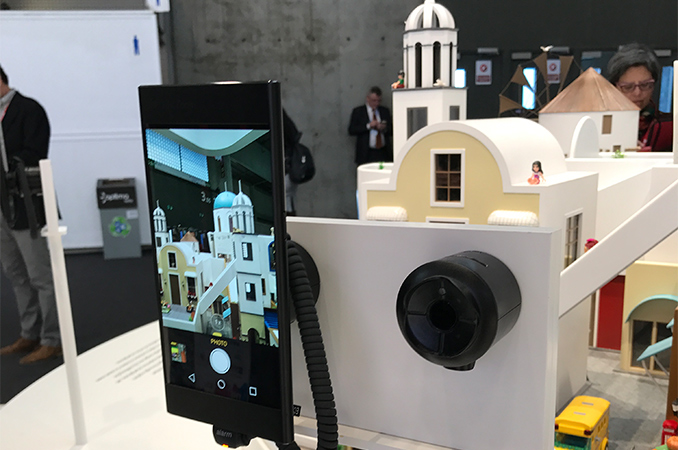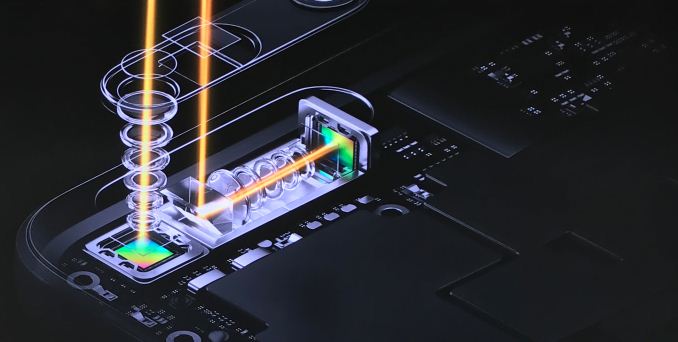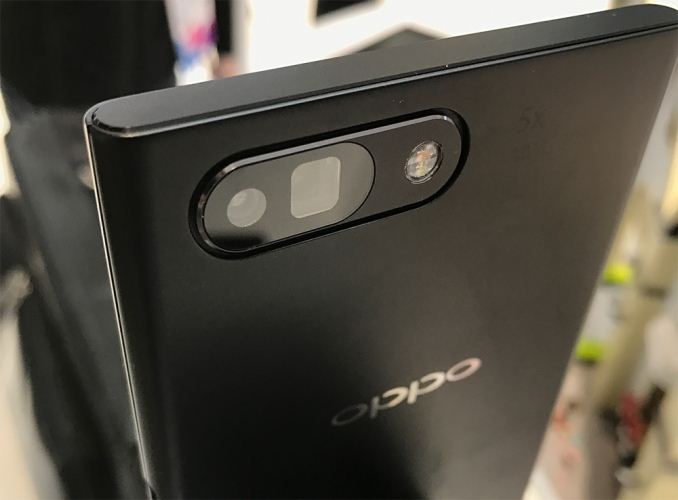MWC 2017: Oppo Demonstrates 5X Optical Zoom for Smartphones
by Anton Shilov on March 13, 2017 10:00 AM EST- Posted in
- Smartphones
- Android
- Trade Shows
- MWC_2017
- Oppo
- Optical Zoom

This year at MWC, Oppo showed off a smartphone prototype that used a new implementation of dual cameras to offer a 5X optical zoom. The company did not reveal anything about the actual plans to use it for products, nor did they reveal the cost of its implementation, but it is likely that it will reach the market sometimes in the future.
Imaging capabilities of smartphones have been evolving rapidly since the introduction of the first handsets with cameras. Throughout the history of phones making photos, manufacturers have developed new lens packs, new CMOS sensors and extensive ISPs (image sensor processors) in order to improve the capability and/or quality of images. For a while, a number of makers tended to install higher-resolution sensors simply because the 'megapixel number' was easier to explain than the quality of optics or advanced ISPs. A lot has changed in the recent years as various smartphone makers have invested in high-end lenses (co-developed with Carl Zeiss, Leica, etc.), developed their own SoCs/ISPs for image processing, and other potential differentiators in a cramped smartphone ecosystem.
So at MWC 2017, multiple smartphone manufacturers demonstrated their products with dual back-facing sensors (RGB+RGB or RGB+IR) to further improve their photography acumen. One of those was Oppo using the two sensors to build a portable camera system with a 5X optical zoom in a very different configuration to what we have seen before.
Optical zoom is not anything new for smartphones, but Oppo’s approach is a little bit different compared to that used by other makers. The 5X dual camera optical zoom from Oppo relies on two image sensors:
- The first is placed inline with the motherboard (just like sensors inside all smartphones) and is equipped with a regular lens pack such that the light hits the sensor with minimal adjustment.
- The second is placed perpendicularly to the motherboard and is equipped with other optics with image stabilization and optical zoom. It is possible that the lens system here can physically move to allow for extra enhancement.
To direct the light to the second sensor, Oppo uses a special prism mirror placed perpendicularly to the motherboard (so, basically, everything works like a periscope) and which it can precisely regulate angles as low as 0.0025 degrees to compensate shaking. To enable 5X optical zoom, an unknown ISP processes images from both sensors.
In its booth at the MWC 2017, Oppo demonstrated promo videos describing the added qualities of its optical zoom capabilities, as well as its optical image stabilization. In addition, the company allowed visitors to try out the prototype devices. One of the concerns, when you use mirrors to transfer light, is that luminous intensity drops as well as a drop in the quality of images. In its video at the trade show, Oppo showcased that the quality of the photos made using the prototype featuring its 5X dual camera optical zoom in dark conditions was better when compared to images made by an 'unknown' rival. With a minor hands-on, we noticed no immediate problems shooting the images in light conditions. There are other phones with prisms used in the market it should be noted, however not quite used in this way.
Oppo did not mention which smartphones are going to use its 5X dual camera optical zoom technology, nor did it mention when. The reference system on the show floor looks slim, so it could be installed into various handsets by Oppo and give the company an opportunity to use it for its top-of-the-range smartphones with large displays, or perhaps for smaller models as well (provided that they have appropriate SoCs/ISPs).
It is noteworthy that in its briefing materials, Oppo did not state the type of sensors in use, but solely emphasized only the 5X dual cam optical zoom. This may likely be a work in progress for a future device, which may or may not be a smartphone.














23 Comments
View All Comments
close - Monday, March 13, 2017 - link
"ISPs (image sensor processors)" - Dial S for Signal.Anyway, I imagined they found a way to squeeze an actual zoom lens (variable focal length) in a phone. "5X zoom" doesn't really make sense since the "zoom" part is basically the ratio between the minimum and maximum focal length the lens offers. No variable focal length, no optical zoom. It's 2 fixed focal lengths and an ISP.
I know marketing is always coming up with snazzy names that fake the real deal but come on, I expected Anandtech to take the extra step in explaining this to readers. Next up you're going to tell us about the phone with infinite zoom because you can always walk the camera closer to the subject or use Photoshop.
philehidiot - Monday, March 13, 2017 - link
Yeh when I saw zoom and what they'd done I expected that they'd be able to move the lens elements for a variable zoom. I suppose though there's nothing stopping them using more space for a variable focal length device for phones targeted at specific markets - i.e. the mobile photographer. Occasionally these kinds of phones crop up and when one comes along that isn't grossly disproportioned (i.e. a compact camera with a phone on the back) I would be tempted to invest.I'm kind of hoping this is proof of concept and the next evolution will be using this to either move the prism between two lens stacks or move the lens stack itself for a variable focal length.
MrSpadge - Monday, March 13, 2017 - link
Good catch. And I wondered why they used 2 cameras at all if they have "zoom".philehidiot - Monday, March 13, 2017 - link
Yeh at first I thought it was a quality issue given you're always going to have some attenuation / distortion going though a different material but it seems like this is just a wide angle and fixed 5X zoom. Not to be sniffed at but equally not the kind of progress I'd like.Because I'm a consumer and therefore impossible to please.
jjj - Monday, March 13, 2017 - link
It would be easier to have a rotating upper bezel and while at it add cams and mics for 360 video, pics and audio.The dimensions of the senors would be a problem, just like they are with their solution as you end up with a 10mm thick phone so ideally the sensor would be at an angle but then you have the mirrors problem.
Anyway , such solutions are rather retro and could have been used a long time ago.
kenansadhu - Monday, March 13, 2017 - link
That's 100% an OPPO thing. They literally did it few years back (search OPPO N1)jjj - Tuesday, March 14, 2017 - link
No you missed the point, i was talking about a system like this one one that gives them Z height for zoom and not a silly front/back thingy.So the top bezel would be like a cylinder with the main cam at the end of it(side of the phone) and it would rotate 90 degrees on the horizontal.
asfletch - Tuesday, March 14, 2017 - link
Like the Nokia N90/N93?serendip - Tuesday, March 14, 2017 - link
What happened to using huge sensors and downsampling to get good quality zoomed images? My ancient Nokia 808 has a 42 mp sensor combined with a custom Toshiba imaging processor. Five years on, I still haven't come across any other phone or compact camera that has the same amount of detail.It's even replaced my DSLR because I hated carrying a big camera with no connectivity. Surely today's Snapdragons and whatnot have imaging blocks capable of processing and down sampling huge images on the fly.
close - Thursday, March 16, 2017 - link
For example the Snapdragon 835's ISP can handle one 32MP camera or two 16MP. That's a long way from the 42MP on the 808. And such a large sensor kind of implies a pretty big camera bump. Which is why dual-camera setups are so popular now and large sensors are relegated to a couple of experiments by Nokia (mainly the 808 and the 1020).